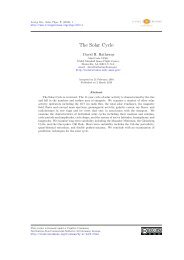PDF (for b&w printout) - Living Reviews in Solar Physics
PDF (for b&w printout) - Living Reviews in Solar Physics
PDF (for b&w printout) - Living Reviews in Solar Physics
You also want an ePaper? Increase the reach of your titles
YUMPU automatically turns print PDFs into web optimized ePapers that Google loves.
The Sun <strong>in</strong> Time: Activity and Environment 35<br />
5.5 The extreme-ultraviolet and X-ray Sun <strong>in</strong> time<br />
The present-day Sun’s corona can be characterized by its total radiative output (mostly <strong>in</strong> the soft-<br />
X-ray regime) of a few times 10 26 erg s −1 at m<strong>in</strong>imum activity level to a few times 10 27 erg s −1<br />
at maximum activity level outside very strong flares; its electron temperature of about 1 – 5 MK,<br />
depend<strong>in</strong>g on the magnetic coronal structure under consideration; and its fill<strong>in</strong>g factor. The latter<br />
is difficult to def<strong>in</strong>e as a large variety of (partly expand<strong>in</strong>g) structures conf<strong>in</strong>ed by closed or open<br />
magnetic fields def<strong>in</strong>e the magnetic corona. Suffice it to say that the strongest magnetic active<br />
regions are conf<strong>in</strong>ed the volumes closely attached to photospheric sunspot complexes, and the latter<br />
cover less than 1% of the solar surface even at activity maximum. Clearly, the solar corona is far<br />
from be<strong>in</strong>g filled by lum<strong>in</strong>ous active regions.<br />
5.5.1 The solar X-ray corona <strong>in</strong> time<br />
Although coronae radiate across the electromagnetic spectrum, the dom<strong>in</strong>ant losses occur <strong>in</strong> the<br />
soft-X-ray range; the radio regime provides complementary diagnostics on non-thermal processes.<br />
I concentrate on these two aspects (see Section 5.7 <strong>for</strong> details on radio emission).<br />
The total X-ray output of a stellar corona depends on the available magnetic energy and is<br />
there<strong>for</strong>e a consequence of the dynamo operation. Younger and more rapidly rotat<strong>in</strong>g stars are<br />
more X-ray lum<strong>in</strong>ous; as is the case <strong>for</strong> UV and FUV radiation, the X-ray output decreases as the<br />
star ages and its rotation period <strong>in</strong>creases. For solar analogs, the decay law is,<br />
LX ≈ (3 ± 1) × 10 28 t −1.5±0.3<br />
9 [erg s −1 ] , (12)<br />
(where t9 is the stellar age <strong>in</strong> Gyr) as derived from small but well-characterized samples (Maggio<br />
et al., 1987; Güdel et al., 1997b). This decay law holds <strong>for</strong> MS stars back <strong>in</strong> time as long as<br />
• Equation 12 predicts a lum<strong>in</strong>osity at or below saturation <strong>for</strong> a solar analog, i.e., LX/Lbol ∼ < 10 −3 ,<br />
or LX ∼ < 4 × 10 30 erg s −1 ;<br />
• the rotation period is a function of age <strong>for</strong> a star of given mass.<br />
The second condition is fulfilled only <strong>for</strong> ages higher than (at least) 100 Myr (Soderblom et al.<br />
1993, see Section 5.2). Consequently, the X-ray lum<strong>in</strong>osity of a solar analog is nearly only a<br />
function of rotation period <strong>for</strong> stars older than ≈ 100 – 200 Myr, and this dependence is given by<br />
LX = 10 31.05±0.12 P −2.64±0.12 [erg s −1 ] (13)<br />
as derived from a sample of nearby solar analogs (Güdel et al. 1997b; see Figure 14; a very<br />
similar decay law is found from measurements conducted with broadband spectrometers on board<br />
XMM-Newton: LX ∝ 4.04 × 10 30 P −2.03±0.35 [erg s −1 ], see Telleschi et al. 2005). The rotationactivity<br />
law (Equation 13) is confirmed by broader studies, also with regard to Rossby number<br />
Ro that is def<strong>in</strong>ed as the ratio between the two time scales of rotation and convection driv<strong>in</strong>g the<br />
dynamo (Ro = P/τc, where τc is the convective turnover time; Noyes et al. 1984; Mangeney and<br />
Praderie 1984). All studies f<strong>in</strong>d roughly LX/Lbol ∝ P −2 <strong>for</strong> late-type stars (e.g., Randich 2000).<br />
Also, other activity <strong>in</strong>dicators such as the surface X-ray flux follow an equivalent law.<br />
Alternatively, the X-ray output roughly scales with the square of the equatorial velocity,<br />
LX ≈ 10 27 (v s<strong>in</strong> i) 2<br />
[erg s −1 ] (14)<br />
(Pallavic<strong>in</strong>i et al., 1981; Ayres and L<strong>in</strong>sky, 1980; Maggio et al., 1987; Wood et al., 1994). The Xray<br />
output is an excellent <strong>in</strong>dicator of dynamo activity. The coronal output is strongly determ<strong>in</strong>ed<br />
by parameters that control the magnetic dynamo.<br />
<strong>Liv<strong>in</strong>g</strong> <strong>Reviews</strong> <strong>in</strong> <strong>Solar</strong> <strong>Physics</strong><br />
http://www.liv<strong>in</strong>greviews.org/lrsp-2007-3



